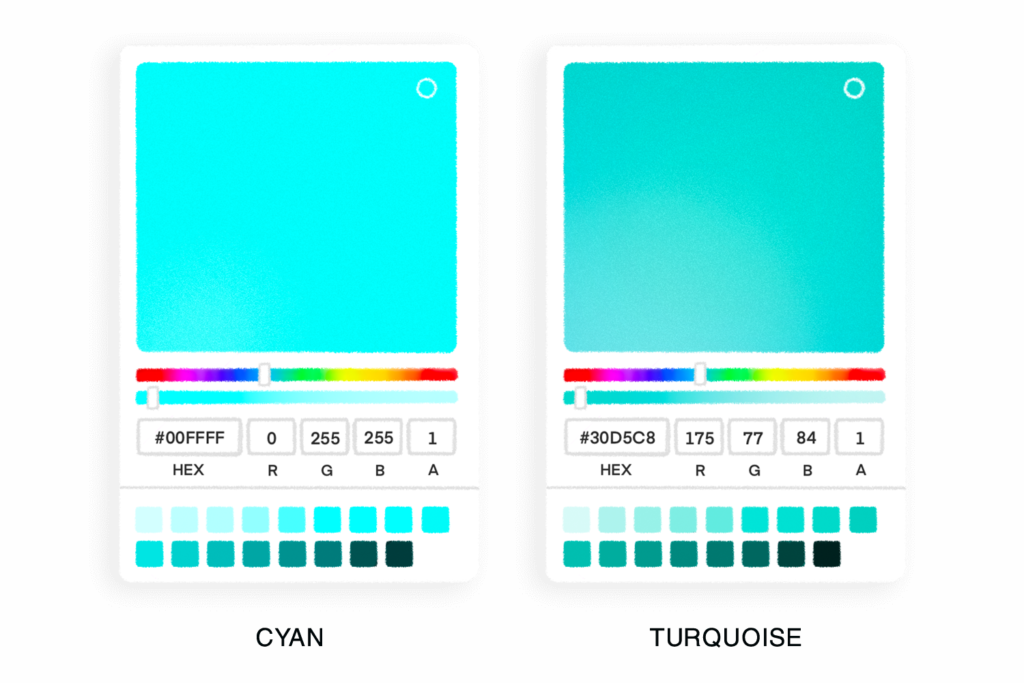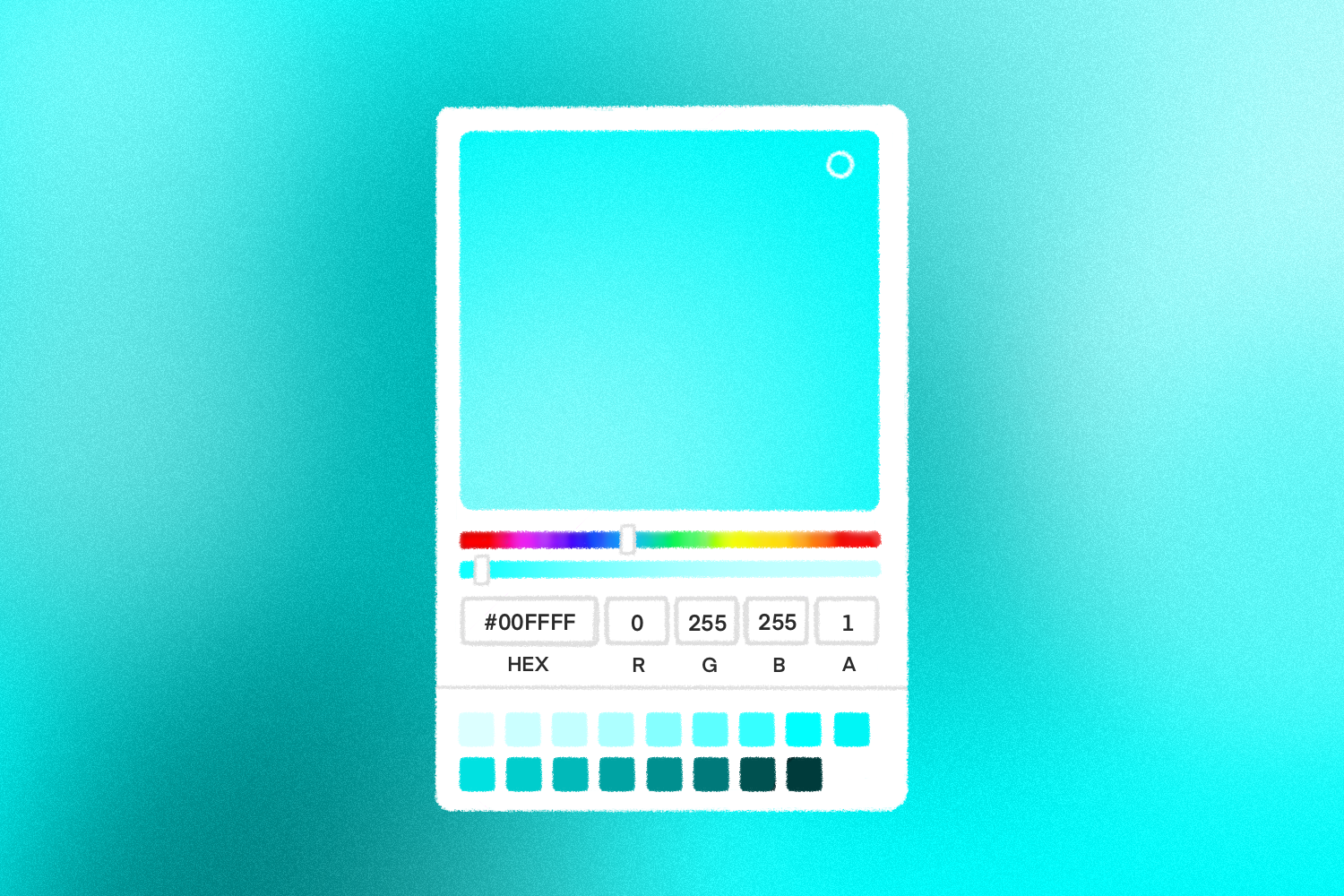What’s hiding behind cyan color meaning?
The choice and combination of colors is not just a matter of the designer’s taste. Behind it lies a whole science from color theory to color psychology.
The choice of colors affects the perception of value and creates a perception of the brand itself. The color theory includes instructions for combining colors, visual effects, and color combinations necessary for graphic design.
Behind every color, there are profoundly psychological and subconscious meanings. In some ways, they can affect your audience even more so than the quality of your product or service.
Color selection adds not only aesthetic but emotional appeal to your designs. The colors of your website say a lot about your brand’s values. Choose the right ones to enjoy improved conversions and user interactivity.
What’s hiding behind cyan color meaning, how to use it in design and combine it with other colors? Let’s find out in this guide about the color cyan.
Which color is cyan?
Cyan is a vibrant, lively green blue that is associated with vitality, youth, and energy. It works well in design and is frequently used interchangeably with turquoise.
Its hex code is #00FFFF. Hex #00FFFF is made of 0% red, 100% green and 100% blue (RGB values).
Cyan pairs well with deep pinks and teals to create bright color palettes. It can also be paired with deep yellows and light purples to soften its electric appearance.
Is it cyan or turquoise?

What is the difference between cyan and turquoise?
Although not quite the same as turquoise, designers sometimes use the two interchangeably.
The primary distinction between Cyan and Turquoise is that Cyan is a visible color between blue and green; subtractive (CMY) is the primary color. Turquoise is an opaque, blue-to-green mineral, a hydrous phosphate of copper and aluminum.
Cyan color information
On the visible light spectrum, cyan is the color between green and blue. It is elicited by light with a predominant wavelength between 490 and 520 nm, between green and blue wavelengths.
Along with magenta and yellow, cyan is one of the primary colors in the subtractive color system, or CMYK color model, which can be overlaid to produce all colors in paint and color printing.
Cyan is created in the additive color system, or RGB color model, which is used to create all of the colors on a computer or television display by combining equal amounts of green and blue light. Cyan complements red; it can be created by subtracting red from grey.
RGB vs CMYK color space
In an RGB color space (made from three colored lights: red, green, and blue), hex #00FFFF is made of 0% red, 100% green, and 100% blue.
In a CMYK color space (also known as process color, or four colors, and used in color printing), hex #00FFFF is made of 100% cyan, 0% magenta, 0% yellow, and 0% black. Cyan has a hue angle of 180 degrees, a saturation of 100%, and a lightness of 50%.
If you’re identifying color for anything digital, you’re working in an RGB colorspace. If the project you’re working on requires percentage representation, cyan is made of 0% red, 100% green, and 100% blue.
On the other hand, if you have to identify color for a print project, you’re most likely using a CMYK colorspace, so the percentages are 100% cyan, 0% magenta, 0% yellow, and 0% black.
Turquoise and cyan both promote and encourage peaceful and calm behavior. They also promote rational/clear thinking, thoughtfulness, cleanliness, and emotional control.
What color is turquoise associated with?
Turquoise is a blue-green color, a catch-all phrase for a wide range of shades between blue and green on the color wheel. The name “turquoise” derives from the French phrase “pierre tourques” meaning Turkish stone.
Turquoise has been used to represent various things over the years, including water, the sky, and even the sea. It is a happy, calm, and friendly color associated with tranquility and serenity. Turquoise radiates the tranquility of blue, the growth of green, and the energy of yellow and can help clarify thinking.
Turquoise color information
Turquoise is a mixture of pale blue and green or blue with a small amount of yellow. Its hex code is #30D5C8.
In an RGB color space (made from three colored lights: red, green, and blue), hex #30D5C8 is made of 18.8% red, 83.5% green, and 78.4% blue.
In a CMYK color space (also known as process color, or four colors, and used in color printing), hex #30D5C8 is made of 77% cyan, 0% magenta, 6% yellow, and 16% black. Turquoise has a hue angle of 175.3 degrees, a saturation of 66.3%, and a lightness of 51.2%.
What does cyan symbolize?
Although the perception of colors is quite subjective, there are universal effects that specific colors evoke.
For example, warm colors (red, orange, yellow) evoke emotions from feelings of warmth and comfort to feelings of anger and hostility. Cold colors (blue, purple, green) evoke emotions from feelings of peace to feelings of indifference.
Cyan is a relaxing and inspiring color that evokes images of crystal waters and is usually associated with liveliness, tranquility, youth, and energy. It is made of green and blue and represents rationality and cleanliness.
How many shades of cyan are there?
There are twelve shades of cyan color: light cyan, aqua, aquamarine, medium aquamarine, pale turquoise, turquoise, medium turquoise, dark turquoise, light sea green, cadet blue, dark-cyan, and teal.
Cyan #00ffff
Aqua #00ffff
Aqua Cyan #01f1f1
Bright Cyan #41fdfe
Crisp Cyan #22ffff
Dark Cyan #008b8b
Electric Cyan #0ff0fc
Desaturated Cyan #669999
Greenish Cyan #2afeb7
Turquoise #06c2ac
Turquoise Blue #00ffef
Light Cyan #e0ffff

How do you combine and use cyan?
Do you know how to pair cyan with other colors to achieve beautiful results?
Cyan works well with its complementary color, red. It can be combined with bold yellow and magenta, two other subtractive color model colors.
Combine cyan with darker blue shades or cool greys and whites for a more conservative color palette.
There’s more than meets the eye when choosing a color scheme. Use science and psychology to guide the use of color in your project and enrich and amplify your message. Turn to cyan color when you want to liven up your creations.
The dynamic energy of cyan color can help you tone down a theme, spice up a background, brighten a mood, or project a sense of excitement.
Every hue has a color meaning that evokes feelings and thoughts. Hue variations of cyan include:
- BLUE — HEX #0000FF
- GREEN — HEX #00FF00
- BLUE GREEN — HEX #0D98BA
Suggested color combination with cyan
- Purple
- Yellow
- Pink
Looking for a cyan color alternative? These would work too:
- Teal
- Aquamarine
- Turquoise
- Electric blue
- Others described as blue-green
Inspire your next design
Ready to create something colorful or any other design you have in mind? Let’s connect and transform your creative idea into an inspiring reality!
